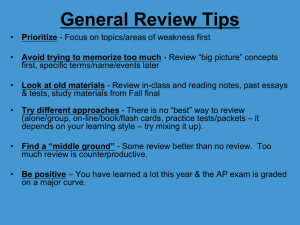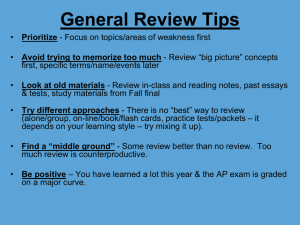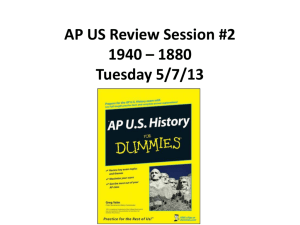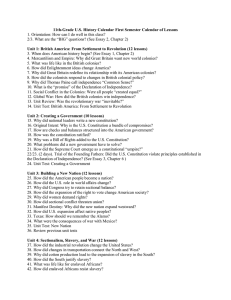Essay Tips
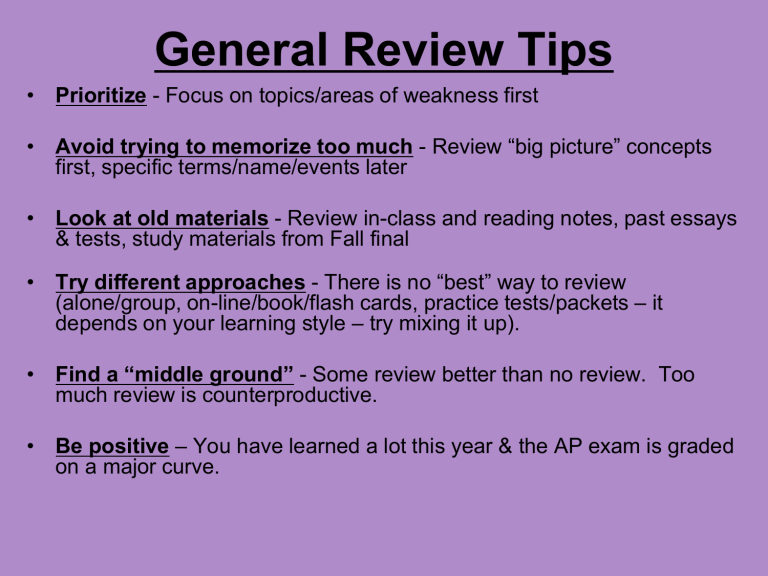
General Review Tips
• Prioritize - Focus on topics/areas of weakness first
• Avoid trying to memorize too much Review “big picture” concepts first, specific terms/name/events later
• Look at old materials - Review in-class and reading notes, past essays
& tests, study materials from Fall final
• Try different approaches There is no “best” way to review
(alone/group, on-line/book/flash cards, practice tests/packets – it depends on your learning style – try mixing it up).
• Find a “middle ground” - Some review better than no review. Too much review is counterproductive.
• Be positive – You have learned a lot this year & the AP exam is graded on a major curve.
AP Exam Multiple Choice Information
• 55 minutes for 80 questions
• Each question has 5 possible answers
• Multiple Choice counts for ½ of total score
• No points lost for wrong or skipped questions.
• Questions get progressively more challenging.
• BIG curve on multiple choice Score over 40 likely earns a 3 (passing score) – over 50 likely earns a 4 and over 60 a 5.
• Chronology of Questions:
– 16 (20%) pre 1790; 36 (45%) 1790-1914; 28 (35%) 1915 – 1990
• Topic of Questions:
– 28 (35%) Politics; 28 (35%) Social/Cultural; 12 (15%) Foreign
Policy; 8 (10%) Economics; 4 (5%) Cultural/Intellectual
AP Exam Essay Information
• There is 1 DBQ essay you must write on and 4 FRQ prompts of which you must write on 2. You will be required to write one FRQ on a topic prior to 1880 and one FRQ on a topic after that date.
• The 5 total essay prompts will range in their topics chronologically and thematically.
AP Essay Writing Tips
• READ prompts multiple times
• Brainstorm & make a quick “plan of attack”
• Introduction needs some brief background on “big picture” followed by an on-topic thesis
• Body paragraphs need to BLEND details with analysis.
(Facts & explanations).
• Grading is “holistic” – no points “taken away”, just earned. If in doubt, make a guess.
A few AP US Exam review websites:
Time lines: http://www.digitalhistory.uh.edu/timeline/timelineO.cfm
http://chaos1.hypermart.net/fullsize/US1750fs.gif
http://www.factmonster.com/ipka/A0902416.html
Terms grouped by “era” http://www.mredmoody.com/ush-ap-preperation.html
http://www.salemwitchtrials.com/history/index.htm
General review websites: http://highschoolsurvivalguide.com/APUSH.html
http://www.apstudynotes.org/us-history/ http://www.historyteacher.net/AHAP/AHAPCourseMainPage.htm
Brainstorm significant people, events, themes, trends and/or ideas from 1606-1800
Key concepts to consider
• Political: Regional differences, government structure,
Enlightenment values, Articles of Confederation,
Constitution, Fed vs. Anti Fed, French & Indian War, clashes with Native Americans, various rebellions against authority
• Social: Regional differences, Role of women, impact of religion & First Great Awakening, Deism, free black communities, reasons for immigration
• Economic: Regional differences, slavery vs. indentured servants, mercantilism, salutary neglect,
Columbian exchange
• Analyze the contribute of TWO of the following in helping establish a stable government after adoption of the
Constitution:
• John Adams
• Thomas Jefferson
• George Washington
Evaluate the extent to which the Articles of
Confederation were effective in solving the problems that confronted the new nation.
“The United States Constitution represented an economic and ideological victory for the traditional political elite.” Assess the validity of that statement for the period
1781 to 1789.
• Analyze the impact of the American
Revolution on both slavery and the status of women in the period from 1775-1800.
Analyze the ways in which
British imperial policies between 1763 and 1776 intensified colonials’ resistance to British rule and their commitment to republican values.
Compare the ways in which religion shaped the development of colonial society (before 1750) in TWO of the following regions:
New England
Chesapeake
Middle Atlantic
• How did economic growth, geographic, and social factors encourage the growth of slavery as an important part of the economy of the southern colonies between 1607 and 1775?
